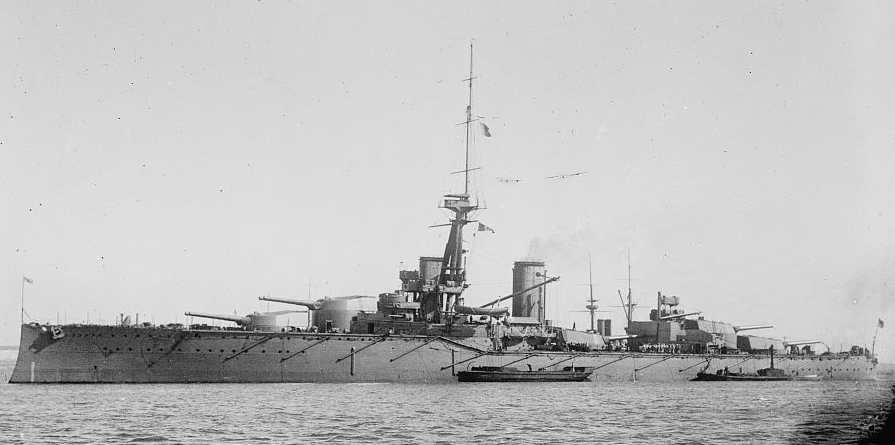
Officially designated as the 12-in 'A' to conceal the increase in caliber size from the 12"/50 (30.5 cm) guns used on previous ships, this was the largest dreadnought battleship gun in the world at the time of its introduction. A Vickers design, these guns are sometimes suffixed as Mark V(L) and Mark V(H), which signifies the weight of the projectiles fired. See below for further details.
The failure of the high-velocity 12"/50 (30.5 cm) Mark XI led to a reconsideration of how to achieve an increase in the destructive power of naval guns. As a result, instead of simply raising the muzzle velocity as had been done in the past, the Admiralty now decided to maximize the weight of the projectiles by increasing the gun caliber. In October 1908 the Admiralty requested Vickers to quote on new designs for 13" (33 cm), 13.5" (34.3 cm) and 14" cm) guns. Part of the design requirements for these weapons was that their projectiles were to have the same nominal residual velocity of 1,640 fps (500 mps) at 8,000 yards (7,320 m) as did projectiles from the 12"/45 (30.5 cm) Mark X. The 13.5" (34.3 cm) design was selected in January 1909 and the first prototype was fired at Shoeburyness late that same year.
The greater momentum inherent in a heavier projectile means that it does not loose its velocity as quickly as does a lighter projectile. So, although the muzzle velocity of the 13.5" (34.3 cm) gun was equal to that of the 12"/45 (30.5 cm) Mark X and less than that of the 12"/50 (30.5 cm) Mark XI, the striking velocity and penetration power of the new gun at long ranges was much greater than that of either of the two smaller guns.
HMS Orion was the first ship armed with these weapons and was the first British dreadnought with all mountings on the centerline and with superfiring turrets fitted on the bow. These new 13.5" (34.3 cm) guns were found to be very reliable and accurate in service with exceptionally low barrel wear. As the design had been given a considerable safety margin, it was decided that later ships could use a heavier shell to increase their hitting power still further. No changes were made to the guns themselves to fire the heavier projectiles, the changes were limited to the shell handling equipment and hoists in the mountings.
Although these guns had a maximum elevation of 20 degrees, as built the prisms in the director and turret sights were only good to slightly over 15 degrees. This was because prior to World War I it was expected that battles would be fought at relatively short ranges and thus the advantages of firing beyond 15,000 yards (13,700 m) were not appreciated. Auxiliary prisms that could be attached to the existing sights and which gave an extra 6 degrees of elevation were produced during World War I, but many ships still lacked these as late as the Battle of Jutland (Skagerrak).
At Dogger Bank two 13.5" (34.3 cm) APC projectiles hit German armor of 30 cm (12") without penetrating. A third shell of this caliber hit Seydlitz on her 23 cm (9") barbette armor at an angle of 33 degrees to the normal. Although this burst without any splinters entering the ship, flash and spalled armor fragments ignited 62 propellant charges and this fire burned out both stern turrets, killing 165 crewmen. Seydlitz was hit again by a 13.5" (34.3 cm) projectile almost the same way during the Battle of Jutland (Skagerrak) and this again holed the armor but was kept out except for flash which ignited four charges.
The "steel choke" problem first found on the 12"/35 (30.5 cm) Mark VIII guns was finally fixed in the later production units of these guns by the introduction of a slow taper fit between the inner A and A tubes. The locating shoulders, which in the earlier guns were well forward and overly concentrated longitudinal stress towards the muzzle, were moved well back in the new guns.
These guns were of the standard wire-wound construction and the first 67 of the 206 guns produced still had the forward locating shoulders and lacked the taper fit. 54 guns were still in existence in 1939 along with six turrets removed from HMS Tiger and HMS Iron Duke which had been placed in storage at Rosyth. An additional three turrets remained on the demilitarized Iron Duke.
During World War II three of these guns were used as railway artillery in the Dover area and were supplied with super charges. A further three guns were relined to 8" (20.3 cm) as a "not very successful super-velocity gun - a remarkable waste of effort" (John Campbell). Four guns together with their slides and cradles from the scrapped battlecruiser HMS Tiger were sold to Turkey before the start of World War II, but none were ever delivered.
| Designation | 13.5"/45 (34.3 cm) Mark V(L)
13.5"/45 (34.3 cm) Mark V(H) |
|---|---|
| Ship Class Used On 1 | (L): Orion class, Lion and Princess Royal
(H): King George V class, Iron Duke class, Queen Mary 2 and Tiger |
| Date Of Design | 1909 |
| Date In Service | 1912 |
| Gun Weight | Without Breech: 167,776 lbs. (76,102 kg) |
| Gun Length oa | 625.9 in (15.900 m) |
| Bore Length | 607.5 in (15.431 m) |
| Rifling Length | 509.6 in (12.943 m) |
| Grooves | 68 |
| Lands | N/A |
| Twist | Uniform RH 1 in 30 |
| Chamber Volume | 19,650 in3 (322.0 dm3) |
| Rate Of Fire | 1.5 - 2 rounds per minute |
- ^As no spare Mark VI guns had been manufactured, one Mark V(H) gun was carried by HMS Erin for a short period while one of her guns was being relined.
- ^A note on Sources: "Naval Weapons of World War One" mistakenly says that Queen Mary carried "(L)" guns but all other sources say that she carried "(H)" guns. This and all other sources agree that she carried the BII* mountings, which were used only with "(H)" guns.
| Type | Bag |
|---|---|
| Projectile Types and Weights 1a 2a | Light 3a APC Mark IIa - 1,266.5 lbs. (574.5 kg) APC Mark IVa (Greenboy) 4a - 1,257 lbs. (570.2 kg) APC 8/16crh - 1,250 lbs. (567.0 kg) CPC - 1,250 lbs. (567.0 kg) HE - 1,250 lbs. (567.0 kg) Shrapnel - 1,250 lbs. (567.0 kg) Heavy
Railway Projectile
|
| Bursting Charge | Light
APC Mark IIa - 40 lbs. (18.1 kg) Lyddite APC Mark IVa - 29.5 lbs. (13.4 kg) Shellite APC 8/12crh - N/A [probably 29.5 lbs. (13.4 kg) Shellite] CPC - 117.4 lbs. (53.3 kg) Black Powder HE - 176.5 lbs. (80.1 kg) Heavy
|
| Projectile Length 2a | Light
N/A Heavy
|
| Propellant Charge - Ships | APC (Light): 293 lbs. (133 kg) MD45
APC (Heavy): 297 lbs. (135 kg) MD45 |
| Propellant Charges - Railway | Standard Charge
299 lbs. (135.6 kg) SC 280 Super Charges 5a |
| Muzzle Velocity - standard charges 6a 7a | APC (Light): 2,582 fps (787 mps)
APC (Heavy): 2,491 fps (759 mps) |
| Muzzle Velocity - super charges 5a | APC (Light): 2,950 fps (899 mps)
APC (Heavy): 2,830 fps (863 mps) |
| Working Pressure | Light - 18 tons/in2 (3,150 kg/cm2)
Heavy - 20 tons/in2 (2,835 kg/cm2) |
| Approximate Barrel Life | Light - 450 rounds
Heavy - 220 rounds |
| Ammunition stowage per gun 8a | Orion, Lion, Queen Mary and Tiger classes: 80 rounds
King George V class: 112 rounds Iron Duke: 100 rounds |
- ^Projectiles were nominally 4crh. The railway guns used a new 1,250 lbs. (567 kg) AP shell of 8/16crh which achieved a much greater range.
- ^2.12.2There were as many as five different vendors for these munitions - Hadfield, Vickers, Firth's, E.O.C. and Cammell Laird - each producing a slightly different projectile from the others. Their APC projectiles had the same burster and total weights, but differed in internal design and had AP caps of different designs and weights. The projectile lengths given above are average numbers.
- ^Although most secondary sources quote a 1,250 lbs. (567.0 kg) weight for the "Light" APC, both the APC Mark IIa (pre-Greenboy) and the APC Mark IVa (Greenboy) actually weighed more than this value as can be seen in the table above. My supposition for this discrepancy is that, like the earlier 12-inch APC Mark VIa, the 13.5-inch APC Mark IIa was originally designed as a 2crh projectile but was later redesigned and changed the ballistic cap to 4crh. This changeover was apparently performed before any of the ships were commissioned.
- ^"Greenboys" were issued starting in 1918.
- ^A Note on Sources: The published works cited below disagree as to the muzzle velocity for these guns. I have chosen to use those values given in "British Naval Guns 1880-1945 No 2."
- ^The muzzle velocities given above are for new guns. When worn and due for replacement, the Mark V(L) gun had a muzzle velocity of 2,100 fps (640 mps).
- ^Ammunition storage given above are the design figures. More rounds were added during the war. Lion was originally given 24 APC, 28 CPC, 28 HE and 6 shrapnel or 86 rounds total per gun. During the early part of the war, this was changed to 110 rounds per gun of 33 APC, 38 CPC and 39 HE. By the time of Jutland (Skagerrak), she carried 66 APC, 22 CPC and 22 HE. The final war outfit was 77 APC (Greenboys) and 33 CPC per gun. The outfits for the other 13.5" (34.3 cm) battlecruisers had similar changes. Battleships generally were rated for 80 rounds but typically carried 110.
| Elevation | Range | Striking Velocity | Angle of Fall |
|---|---|---|---|
| 1.14 degrees | 2,500 yards (2,290 m) | 2,326 fps (709 mps) | 1.23 |
| 2.40 degrees | 5,000 yards (4,570 m) | 2,117 fps (645 mps) | 2.73 |
| 3.88 degrees | 7,500 yards (6,860 m) | 1,931 fps (589 mps) | 4.66 |
| 5.55 degrees | 10,000 yards (9,140 m) | 1,750 fps (533 mps) | 7.08 |
| 7.47 degrees | 12,500 yards (11,430 m) | 1,610 fps (491 mps) | 10.11 |
| 9.64 degrees | 15,000 yards (13,720 m) | 1,487 fps (453 mps) | 13.78 |
| 12.08 degrees | 17,500 yards (16,000 m) | 1,395 fps (425 mps) | 18.00 |
| 14.78 degrees | 20,000 yards (18,290 m) | 1,332 fps (406 mps) | 22.73 |
| 20.00 degrees | 23,820 yards (21,780 m) | --- | --- |
Although this table is marked as "1,250 lbs." in ADM 186/169, it may actually be for the 1,266.5 lbs. (574.5 kg) APC Mark IIa in this same document.
| Elevation | Range | Striking Velocity | Angle of Fall |
|---|---|---|---|
| 1.17 degrees | 2,500 yards (2,290 m) | 2,305 fps (703 mps) | 1.23 |
| 2.48 degrees | 5,000 yards (4,570 m) | 2,117 fps (645 mps) | 2.75 |
| 3.95 degrees | 7,500 yards (6,860 m) | 1,940 fps (591 mps) | 4.65 |
| 5.60 degrees | 10,000 yards (9,140 m) | 1,783 fps (543 mps) | 7.03 |
| 7.50 degrees | 12,500 yards (11,430 m) | 1,643 fps (501 mps) | 9.90 |
| 9.60 degrees | 15,000 yards (13,720 m) | 1,524 fps (565 mps) | 13.40 |
| 12.05 degrees | 17,500 yards (16,000 m) | 1,429 fps (436 mps) | 17.5 |
| 14.75 degrees | 20,000 yards (18,290 m) | 1,365 fps (416 mps) | 22.00 |
| 20.00 degrees | 23,740 yards (21,710 m) | --- | --- |
| Elevation | Range with Supercharges |
|---|---|
| 40 degrees | 48,900 yards (44,700 m) |
Ranges with standard charges for the older 1,250 lbs. (567 kg) 4crh APC shells would be equivalent to those in the previous table.
| Elevation | Range with Supercharges |
|---|---|
| 40 degrees | 40,600 yards (37,120 m) |
Ranges with standard charges for the 1,400 lbs. (635 kg) APC shells would be equivalent to those in the previous table.
| Range | KC-type Side Armor | Deck Armor | Striking Velocity |
|---|---|---|---|
| 0 yards (0 m) | 17.3" (439 mm) | --- | 2,700 fps (823 mps) |
| 10,000 yards (9,144 m) | 12.2" (310 mm) | --- | 1,900 fps (579 mps) |
- Data in both tables is from "British Battleships of World War Two."
- The penetration figures in these tables are for an uncapped AP shell striking the plate at 90 degrees, i.e., with the axis of the shell perpendicular to the face of the plate. A capped shell would give about 10 to 20% improvement at low velocities and about 30 to 50% at high velocities.
- Note that the muzzle velocity for the 1,250 lbs. (567 kg) APC shell in the upper table is much higher than that given in most references. For that reason, I believe that these to be proofing values and not what would be achieved in service.
- It should be noted here that British APC projectiles before the introduction of the "Greenboy" design were prone to breaking up and suffering premature detonation upon striking thick armor plates.
| Designation 1c | Two-gun Turrets
Orion [except Conqueror] (5), Lion (4) and Princess Royal (4): Mark II 2c Queen Mary (4) and King George V [except Ajax] (5): Mark II* Iron Duke [except Benbow] (5) and Tiger (4): Mark II** 3c Conqueror (5): Mark III 4c Ajax (5): Mark III* 4c Benbow (5): Mark III** 4c |
|---|---|
| Weight | Mark II: 600 tons (610 mt)
Others: N/A |
| Elevation 5c | Ships: -3 / +20 degrees
Railway: 0 / +40 degrees |
| Rate of Elevation | Mark II and Mark II*: 3 degrees per second
Mark II**, Mark III and Mark III*: 5 degrees per second |
| Train 6c 7c | Forward and aft turrets: about -150 / +150 degrees
Q turret: about 30 to 150 degrees on either side |
| Rate of Train | N/A |
| Gun Recoil | N/A |
| Loading Angle | Any 8c |
- ^Guns in all mountings were individually sleeved. Mountings with a single asterisk (*) after the Mark Number indicate that they were modified to handle the 1,400 lbs. (567 kg) projectiles. Mountings with a double asterisk (**) after the Mark number indicate a further modification to increase the elevation speed by enlarging the elevation cylinder. These mountings were equipped with the newly invented swashplate training engine which gave them smoother training movements. Two 7-cylinder swash plate engines were provided for each mounting.
- ^The Mark II turrets were very similar to the previous BXI mountings used for the 12"/50 (30.5 cm) guns of the St. Vincent class. As the designers of the Mark II mounts kept approximately the same dimensions as those for the BXI, the Mark II mounts were cramped and compromises in shell handling were accepted. For example, the projectiles in the Mark II were hoisted at a 38 degree angle in order to maintain about the same hoist dimensions as in the earlier mounting, although the projectiles entered and exited the cage hoist horizontally. Auxiliary supply propellant was eliminated and in their place were secondary projectile and cage hoists outboard of the guns. Stowage for eight rounds per gun were provided in the Mark II and II* gunhouse, with two powered derricks provided to lift the shells. These derricks also lifted shells from the secondary supply hoists mentioned above. Bins for six rounds per gun were arranged in the working chamber below the gunhouse and an emergency shell and cordite supply route was built into the main trunk. The main hoists combined the projectile and propellant cages such that when at the lowest level, the shell cages were in line with the shell bogies in the shell room and the propellant cage was in line with the cordite hoppers in the magazine. When the cage reached the working chamber, the projectile and propellant cartridges were automatically tipped onto loading trays where powered rammers pushed them into the gunloading cage. The Mark II* had improved chain rammers and breech mechanisms and a new type of shell room bogie was introduced that eased moving shells from storage into the hoists. Previously, shells were simply rolled over to the hoists.
- ^The Mark II** turrets had a wider hoist trunk which allowed the shells to be hoisted horizontally.
- ^4.14.24.3The Mark III series turrets were the first large-caliber mountings to be designed by the Coventry Ordnance Works. These differed considerably from the Elswick and Vickers designs with the main differences in the elevating hydraulics, the gun loading cage and hoist, the training engine, the rammer control, the depression control and the shield. In these mountings, the hydraulic cylinder worked directly on the slide and two seven-cylinder engines replaced the swashplate. The shells were hoisted horizontally from the magazines to the handling room, but they were hoisted inclined in the upper hoist as in the Mark II. It is noted in "The Big Gun" that the ammunition supply arrangements reflected the inexperience of the Coventry designers and that this resulted in more hand work being necessary than in the Mark II mountings. From "British Naval Gun Mountings:"
An official manual criticised the gun loading cages: "The whole system is heavy and clumsy and involves many almost unavoidable accidents during loading."
These problems were almost certainly the result of the Admiralty specifically requiring that Coventry was not to get technical help from the more experienced firms of Armstrong and Vickers but were instead to use their own designs.
The differences between the Mark III, Mark III* and Mark III** mountings are not known at this time, but presumably the latter versions were fixes for some of the problems found with the Mark III. Coventry made only eight more heavy mountings, which were all copies of the Elswick 15-inch (38.1 cm) design.
- ^As built the prisms in the director and turret gunsights controlling these mountings allowed ranging only up to an elevation of +15' 21". By the time of Jutland (Skagerrak), some ships had been given removable "super elevation" prisms that increased the usable elevation by 6 degrees and which could be attached to the existing director sights and to the center position turret sights, but this process was not completed until 1917.
- ^Superfiring turrets could not fire within 30 degrees of the axis because the blast effects would have penetrated into the lower turrets through the sighting hoods. 'A' turret on HMS Tiger was to an experimental design whereby the two sighting hoods for the gunlayers were replaced by armored horizontal periscope sight ports on the turret sides. The center sighting hood used by the turret trainer was left in place which negated any advantage to blast protection. These side ports were not repeated on later ships as it was found that they wooded earlier than the sighting hoods on the roof.
- ^"Q" turret on Tiger was in a more favorable position which increased its firing arc to 60 degrees before the beam and 90 degrees abaft it on either side, although it could not fire directly aft below about 10 degrees of elevation. Firing aft at angles between about 170 to 190 degrees would also affect wireless antennas on any British capital ship of this era.
- ^Although these mountings were designed to be loaded at any elevation angle, it was found that HMS Lion and HMS Princess Royal, which were equipped with two hydraulic run-out pumps to operate all four turrets, "stalled" at high elevations which slowed their reloading cycles. As a result, loading for these ships was normally performed at a low angle. The later Orion class battleships and the battlecruisers Queen Mary and Tiger were given three pumps and the later battleships were given four pumps. At the Dogger Bank battle it took the battlecruisers 11 seconds to run their guns out at high elevations and the guncrews adapted by lowering the guns before reloading. This would have "unsighted" the gun layers, which must have caused difficulties in maintaining target lock.
- The gun axes were 90 in (228.6 cm) apart on all mounting types.
- Armor thickness for battleships as given in "Naval Weapons of World War One" by Norman Friedman:
Face: 10.78 in (27.4 cm) (440 lbs.)
Sides: 10.78 in (27.4 cm) (440 lbs.)
Rear: 10.78 in (27.4 cm) (440 lbs.)
Front Roof: 3.92 in (10.0 cm) (160 lbs.)
Rear Roof: 2.94 in (7.5 cm) (120 lbs.)
Floor: 1.96 in (5.0 cm) (80 lbs.) + 1.96in (5.0 cm) (80 lbs.) splinter protection on overhanging floorArmor thickness for battlecruisers as given in "British Battleships of World War One" by R.A. Burt:
Face: 8.82 in (22.4 cm) (360 lbs.)
Sides: 8.82 in (22.4 cm) (360 lbs.)
Rear: 7.84 in (19.9 cm) (320 lbs.)
Front Roof: 3.19 in (8.1 cm) (130 lbs.)
Rear Roof: 2.45 in (6.2 cm) (100 lbs.)
Floor: 1.96 in (5.0 cm) (80 lbs.) + 1.96 in (5.0 cm) (80 lbs.) splinter protection on overhanging floor.Face, Sides and Rear used KC armor while the roofs used KNC armor.
Following the Jutland (Skagerrak) battle, surviving battlecruisers and at least some battleships had 1 in (2.54 cm) armor plates added to their turret roofs and magazine crowns. See photograph of HMS Benbow below.
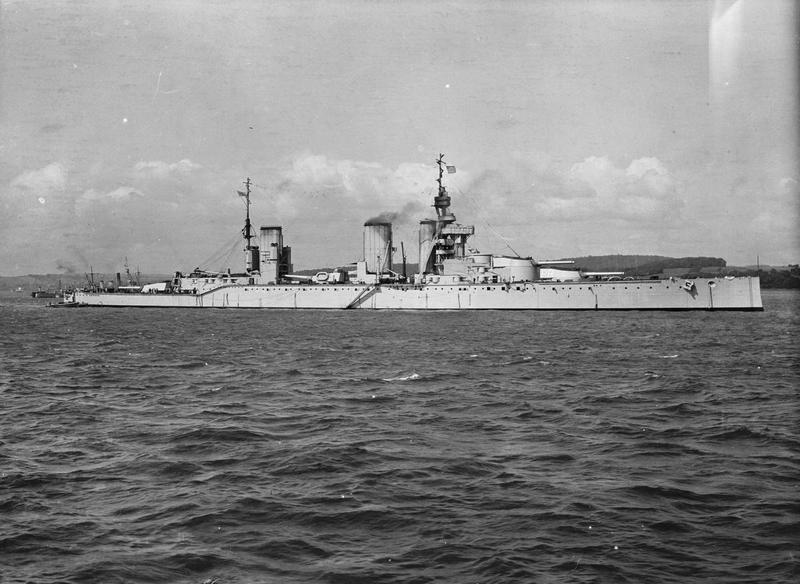
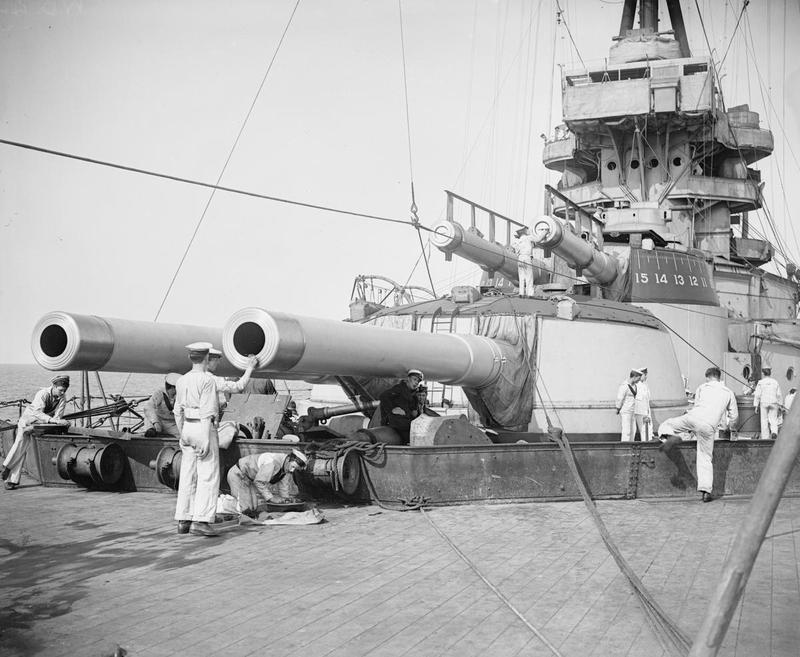



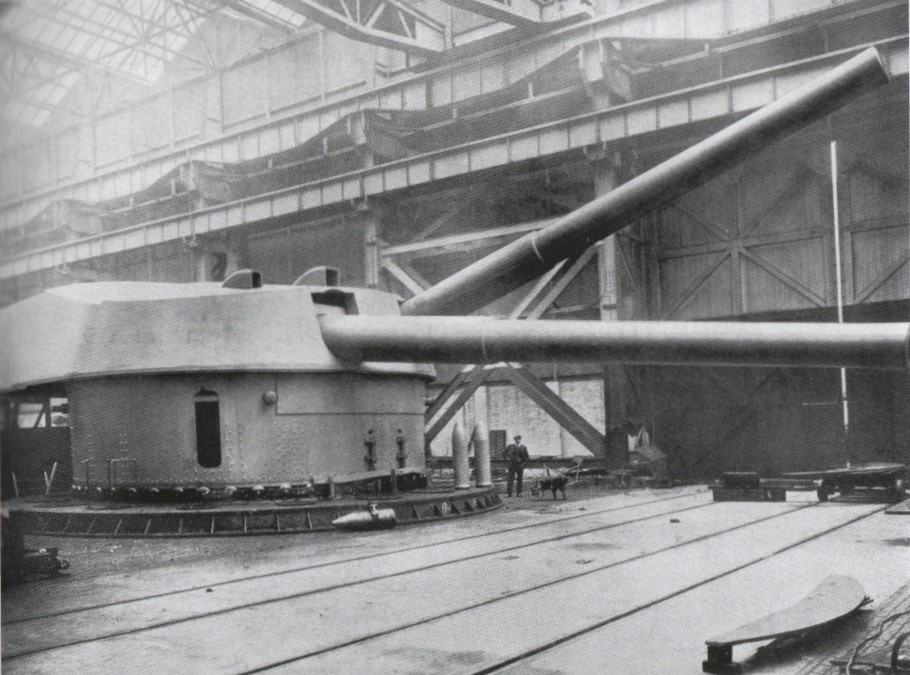
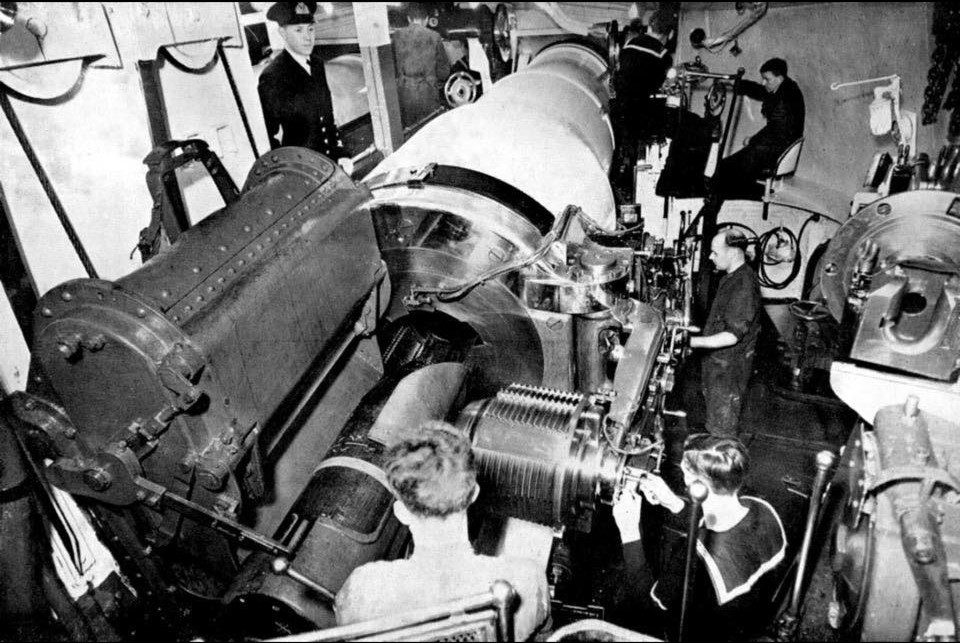
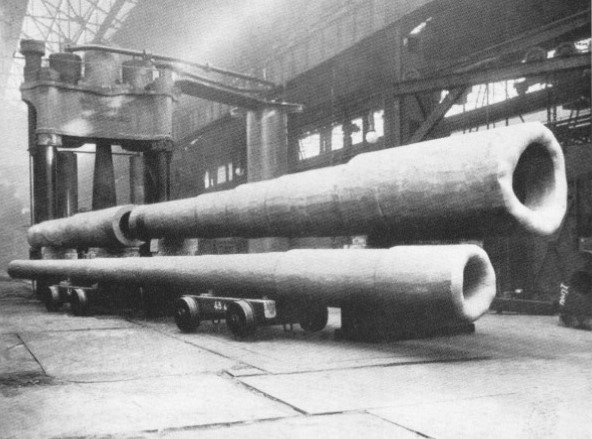

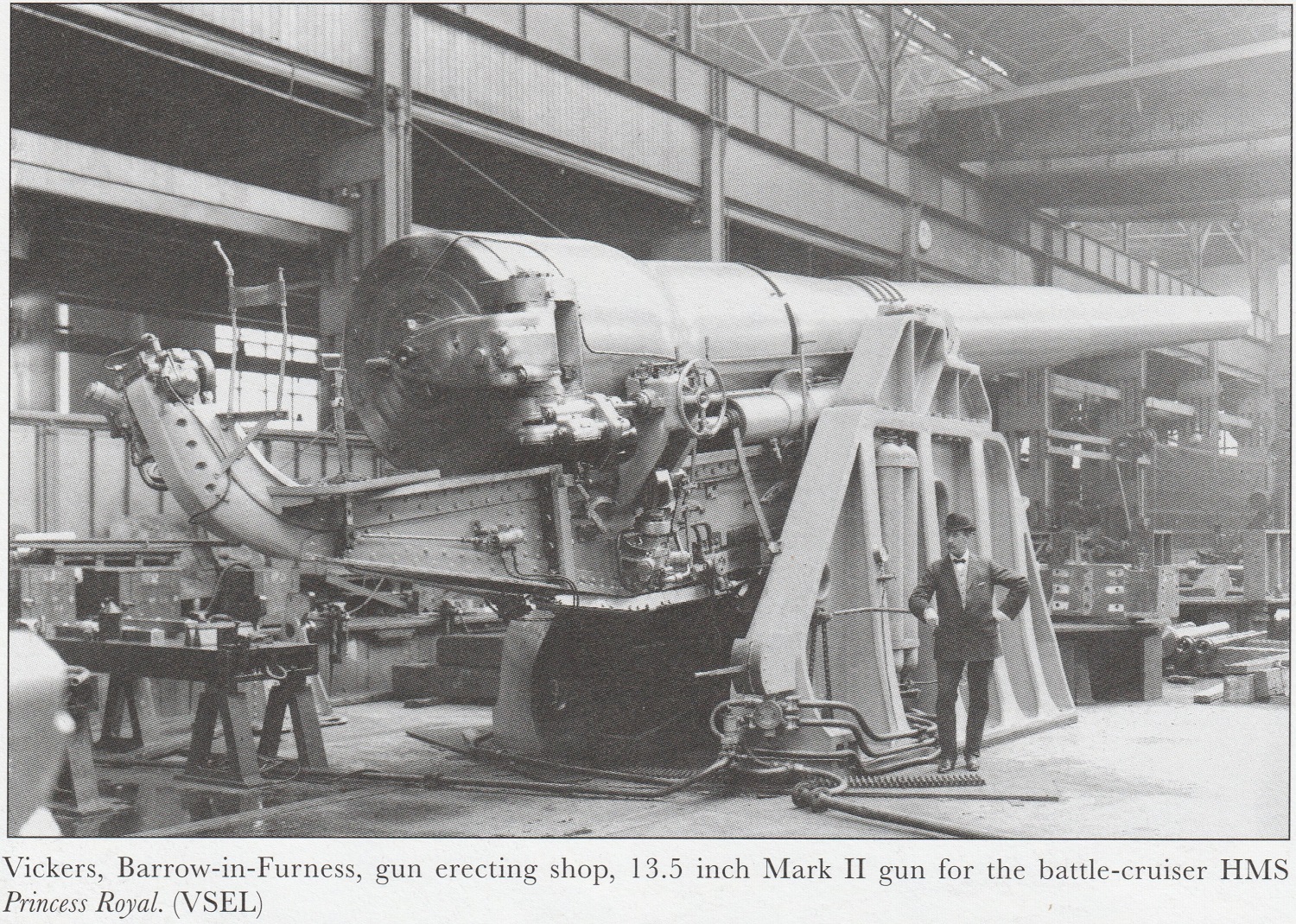
Images at The Vickers Photographic Archive
"The Grand Fleet: Warship Design and Development 1906-1922" by D.K. Brown
"British Battleships of World War One" by R.A. Burt
"British Naval Gun Mountings: From 1890: 18-inch to 4.5-inch Mark 8" by Ian Buxton
"Naval Weapons of World War Two," "Jutland: An Analysis of the Fighting," "The Battle of Tsu-Shima" article in "Warships Volume II," "Warship Special 1: Battle Cruisers" and "British Naval Guns 1880-1945 No 2" article in "Warships Volume V" all by John Campbell
"Battleship Design and Development 1905-1945" and "Naval Weapons of World War One" both by Norman Friedman
"The Big Gun: Battleship Main Armament 1860-1945" by Peter Hodges
"The Battleship Builders: Constructing and Arming British Capital Ships" by Ian Johnson & Ian Buxton
"The Admiralty Regrets: British Warship Losses of the Twentieth Century" by Paul Kemp
"British Battleships: 1860 - 1950" by Oscar Parkes
"British Battleships of World War Two" by Alan Raven and John Roberts
"Battlecruisers" by John Roberts
"Dreadnoughts in Camera: Building the Dreadnoughts 1905-1920" by Roger D. Thomas and Brian Patterson
"The Royal Navy in Old Photographs" by Wilfrid Pym Trotters
---
ADM 186/169 "Shell Committee: Reports 1917 and 1918"
---
Special help from Neil Stirling and Anthony Lovell of
Dreadnought Project
04 December 2006 - Benchmark
01 May 2009 - Added picture of HMS Monarch
29 December 2011 - Added information about hits on Seydlitz and ammunition outfits on battlecruisers
11 February 2012 - Updated to the latest template
25 November 2012 - Corrected comment about auxiliary prisms
26 November 2015 - Added mounting note about "A" turret on HMS Tiger
02 December 2015 - Changed Vickers Photographic Archive links to point at Wayback Archive
22 February 2016 - Added ammunition details, armor thickness and information about reloading at high elevations
16 September 2016 - Converted to HTML 5 format
02 January 2020 - Added information on remaining guns and turrets in 1939, added note regarding "(H)" guns on
HMS Queen Mary, reorganized notes, minor formatting changes
29 February 2020 - Added note regarding weight of Light APC
01 May 2021 - Added photographs of 13.5"/45 Mark V guns being manufactured
22 August 2022 - Added photograph of 13.5"/45 Mark V gun in workshop
27 May 2023 - Added photograph of HMS Iron Duke turret interior
14 November 2024 - Added note regarding extra armor protection added to battlecruisers following the Jutland (Skagerrack) battle
10 March 2025 - Added mounting notes on Coventry designs,battleship ammunition stowage and photograph of HMS Conqueror turret
